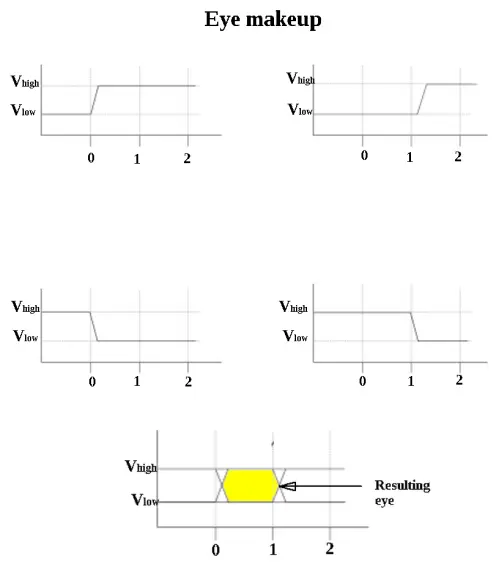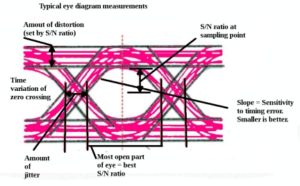An eye diagram is used in electrical engineering to get a good idea of signal quality in the digital domain. To generate a waveform analogous to an eye diagram, we can apply infinite persistence to various analog signals a well as to quasi-digital signals such as square wave and pulse as synthesized by an arbitrary frequency generator (AFG).

The eye diagram takes its name from the fact that it has the appearance of a human eye. It is created simply by superimposing successive waveforms to form a composite image. The eye diagram is used primarily to look at digital signals for the purpose of recognizing the effects of distortion and finding its source.
To demonstrate using a Tektronix MDO3104 oscilloscope, we connect the AFG output on the back panel to an analog input channel on the front panel and press AFG so a sine wave displays. Then we press Acquire. From the menu across the bottom, we press the soft key that corresponds to Waveform Display. On the right, we use Multipurpose Knob a to set the oscilloscope for infinite persistence. We see displayed a succession of waveforms one upon another.
It is a simple matter to probe different locations in a circuit, looking at the eye diagram, to localize any problems. For example, if a run of cable were to have a fault caused by pinch or kink, eye diagrams observed at both ends would differ, and the cable could be repaired or more likely the entire run could be replaced.
Ideally, the eye diagram for digital signals would consist of two parallel lines with an instantaneous rise and fall times virtually invisible. In the real world, even a reasonably good and quite acceptable digital signal will exhibit some amount of amplitude and timing variation, which will show up as discrete lines that are not exactly where they belong but will nonetheless suffice. If there are enough of them, darkened areas will appear.

As far as identifying damaging anomalies, this is all a matter of degree. There is no substitute for looking at eye diagrams of existing known good signals. A good plan would be to save in flash drives eye diagrams from signals taken at various points in properly functioning digital equipment.
It is important to realize what is shown in an eye diagram and what is not shown. In digital transmission, a succession of ones and zeroes flows to the receiver. The transmission can consist of a long series of ones, a long series of zeroes, a regular or irregular sequence that repeats periodically, a quasi-random series or any combination. The eye diagram will reveal whether everything works as intended or if there are faults that garble the transmission, causing, for example, the reception of a zero when a one has been sent.
The eye diagram will not reveal whether an incorrect logic state has been sent through a programming error or hardware fault. However, this does not apply where certain tests are being made, as when a transmission pattern is known at both ends.
Eye diagram analysis yields impressive amounts of information. Eye diagram analysis is valuable in design, debugging, and maintenance. As the frequency rises, new issues emerge. Transmission line phenomena must be understood and confronted, especially regarding impedance matching. Slight manufacturing and installation errors degrade characteristic impedance, and the resulting data reflections and collisions increase the percentage of error. Even slight PCB trace misdesign or construction error can bring down an entire network. The most viable method for identifying and locating such faults is by comparing before and after (with respect to the data stream) eye diagrams.

When the flow is controlled by a clock, the oscilloscope can generate an eye diagram by overlaying successive segments. Triggering may occur on rising or falling edges. The resulting eye diagram will deviate to a greater or lesser degree from the rectangular box that would correspond to a perfect transmission.
The top bar in an eye diagram is the result of discrete high logic states that coincide vertically but not horizontally. Overlapping low logic states create the continuous bottom bar. Those ubiquitous Xs that are a familiar feature of eye diagrams are due to rising and falling edges that are superimposed at regular intervals.
High-speed digital transmission is characterized by the introduction into the signal of jitter. It is to be expected that an electronic signal will be periodic to a certain extent. Jitter is the deviation from this periodicity and as such it is harmful in terms of signal fidelity. What appears at the receiving end is not true to the intent at the transmission end when there is any degree of jitter. This applies to amplitude, frequency and phase. Accordingly we may define jitter as a kind of timing error, a consequence of rise and fall time error. Needless to say, jitter shows up plainly in an eye diagram. The bottom line on jitter is that it comes into being from a combination of interference among symbols, crosstalk, reflections, thermal effects and various random phenomena that are omnipresent in electronic systems.
A higher bit rate always translates to a vertically smaller eye opening. Concurrently, timing error as manifested in jitter comprises a larger fraction of the waveform, so we may look for more data errors.
Poor terminations at media ends increase the number of data reflections, a fact also revealed in the appearance of the eye diagram. Lines which should follow a single path become more separated, resulting in a chaotic appearance in the eye diagram, a sure sign that there are problems in the system.
Eye diagram analysis is not the same as a bit error rate investigation, but the two techniques are often used in conjunction.
Bit error rate (BER) is calculated as the number of bit errors per unit of time. Bit synchronization errors are a factor, as well as distortion, interference and noise. BER is usually expressed as a percentage. It can be automatically detected and displayed in an alphanumeric readout, so this metric can be checked and logged in the course of routine maintenance inspections, often pointing to developing problems preceding an actual outage.
Closely related is the packet error rate (PER). A packet is considered incorrect if it contains one or more invalid bits. Frames, blocks and symbols are subject to similar analysis. In wireless transmission, BER may be related to adverse weather conditions or odd causes such as seasonal leaving out of deciduous trees impacting the signal path.
The quality of signal transmission can be checked by means of a bit error ratio tester (BERT), which is a portable instrument used to measure the effects of noise, distortion, etc. Incorporated within this instrument are a pattern generator, error detector, clock signal generator to synchronize these blocks, a digital communication analyzer for displaying transmitted and received signals, and equipment that performs electrical-to-optical and optical-to-electrical conversion.
The most common method of signal discrimination is for the receiving end to determine at a particular moment whether the incoming signal is higher or lower than a specified voltage level. This determines whether the received signal is logic high or logic low.
The point of demarcation may be moved about on the waveform. The usual solution is to place it away from high level, low level, rising edge or falling edge. That way it will be near the center of the eye where it can be readily identified.
As an experimental tool for evaluating devices, circuits, equipment or entire networks, the eye diagram is superb because it shows the total effect of any noise or waveform due to intersymbol interference or EMI effects. Moreover, these disturbances can be localized by observing changes in the eye pattern as the probing is moved about. Changes in cable routing and characteristic impedance adjustments will suggest themselves as eye patterns are studied.

Leave a Reply
You must be logged in to post a comment.